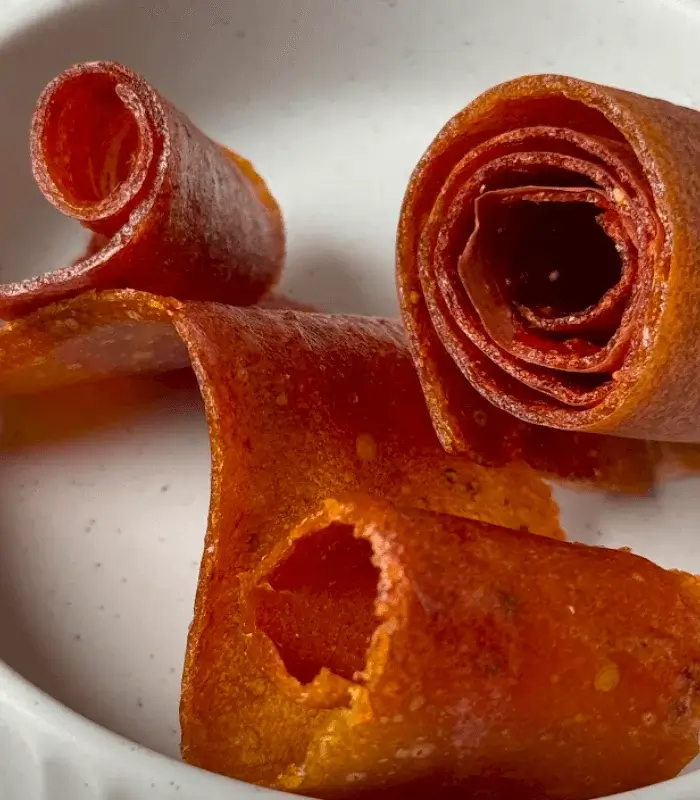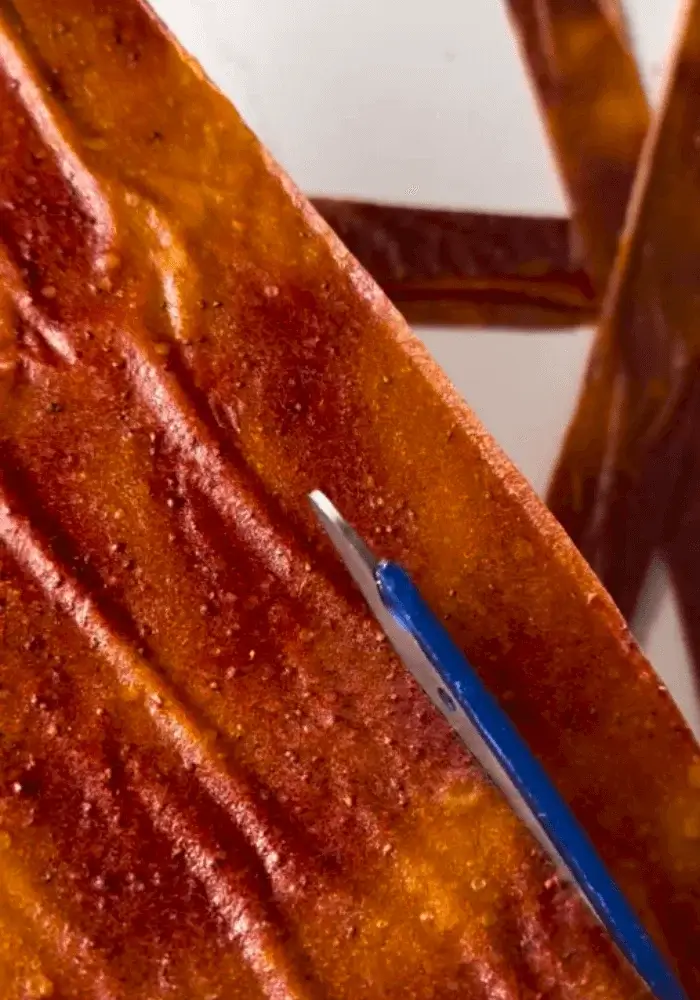Natural Mango Strawberry Fruit Leather
We may earn a commission from recommended products, at no extra cost to you. See Disclosure.
- Scissors
INGREDIENTS
- 1½ cups/225 grams strawberries, fresh or frozen fruit that’s been thawed
- 1½ cups/225 grams mango, fresh or frozen fruit that’s been thawed
- 2 tablespoons/30 milliliters lemon juice
- 2 tablespoons honey, to taste
INSTRUCTIONS
- If you are using frozen strawberries or mango, make sure to thaw them before beginning. Cut the mango and strawberries into small cubes and transfer each fruit to a food processor.
- Process each fruit separately until it forms a smooth puree. Add 1 tablespoon of lemon juice and 1 teaspoon of honey (adjust the honey to taste) to each mixture, blending well.
- Spread the mixtures onto a baking sheet lined with parchment paper, or if using a dehydrator, place them on the drying racks. For a visually appealing effect, pour each fruit puree in separate lines and lightly swirl them together to create a marbled look.
- Preheat your oven to 120-140°F (50-60°C). Place the baking sheet in the oven and let the mixture dry for 6-8 hours, depending on the thickness of the layers. Check occasionally until the leather is fully dried and no longer sticky to the touch.
- Once the leather is completely dried, remove it from the oven and cut it into squares or strips. Store the leather in an airtight container to keep it fresh.

FAQ
What is the difference between fruit leathers and roll-ups?
Strawberry fruit leather and fruit roll-ups are both made from pureed fruit that is dried, but there are a few key differences. Fruit leather refers to a thin, flat sheet of dried fruit, which is typically cut into squares or strips. It’s often homemade and can have a more natural texture. Fruit roll-ups, on the other hand, are a brand name and typically refer to a specific product that is more processed and often thicker. While strawberry fruit leather is made with fresh fruit and simple ingredients, fruit roll-ups may include added sugars, preservatives, and flavorings.
Can I make strawberry fruit leather without a dehydrator?
You can absolutely make strawberry fruit leather without a dehydrator. The most common alternative is using an oven. Preheat the oven to a low temperature (120-140°F or 50-60°C), and spread the fruit puree onto a baking sheet lined with parchment paper. Place it in the oven and let it dry for 6-8 hours, checking periodically for dryness. The goal is to achieve a firm, non-sticky texture. You can also use a convection oven to circulate air for a more even drying process. Just ensure the temperature is low to prevent cooking the fruit rather than dehydrating it.

What other fruits can I use to make fruit leather?
You can make fruit leather from almost any fruit that can be pureed, such as mangoes, apples, peaches, blueberries, or even a mix of different fruits. If you’re using fruits with higher water content, like watermelon or oranges, you may need to cook them down first to remove excess moisture. For strawberry fruit leather, you could mix strawberries with other fruits like raspberries or bananas to create different flavor combinations. The key is to blend the fruit until smooth and follow the drying process to create a firm, non-sticky result.
Can I add sugar to this strawberry fruit leather recipe?
You can add sugar to strawberry fruit leather to enhance its sweetness, but it’s generally not necessary. Fresh strawberries are naturally sweet, and honey or maple syrup can often be used as a more natural sweetener. However, if you prefer a sweeter fruit leather, you can add sugar to taste. Typically, adding about 1-2 tablespoons of sugar per cup of fruit puree is sufficient, but you can adjust based on the sweetness of the fruit you’re using. Keep in mind that too much sugar could affect the drying process and texture.
How do I store strawberry fruit leather to keep it fresh?
To keep strawberry fruit leather fresh, store it in an airtight container or wrap individual strips in wax paper or plastic wrap. You can keep it at room temperature for up to two weeks. For longer storage, place it in the fridge or freezer. When freezing, make sure the leather is tightly wrapped or sealed in a freezer-safe bag to prevent freezer burn. Properly stored, strawberry fruit leather can last for up to 6 months in the freezer. Always check for any signs of spoilage, like mold or off smells, before consuming.

Is it possible to make this recipe without lemon juice?
While lemon juice is often added to fruit leather recipes to help preserve color and balance the sweetness, it is not absolutely necessary. You can omit the lemon juice, but the strawberry fruit leather may lose some of its vibrant color and could taste a little sweeter. If you’re looking for an alternative, you can use other citrus juices, like lime, or even a small amount of apple cider vinegar to provide acidity without affecting the overall flavor too much. Just keep in mind that omitting lemon juice may result in a slightly different texture and taste.
How do I prevent the leather from becoming too sticky?
To prevent your strawberry fruit leather from becoming too sticky, make sure you’re drying it long enough. If the leather is still sticky after several hours, it likely needs more drying time. Ensure your oven or dehydrator is set to a low temperature and check the leather every couple of hours for the right texture. If using a dehydrator, try increasing the air circulation, and if using an oven, avoid opening the door too frequently. Another helpful tip is to use a silicone baking mat or parchment paper, which can help prevent sticking and make removal easier once it’s dry.
Can I use honey instead of sugar?
Yes, honey can be used as a sweetener in strawberry fruit leather instead of sugar. Honey not only adds sweetness but also contributes a slight floral flavor that can complement the strawberries. If you’re using honey, you may need less than you would if using sugar, as honey is sweeter by volume. About 1-2 tablespoons of honey per cup of fruit puree is usually enough, but you can adjust the sweetness to your preference. Honey also adds a bit of moisture, so be mindful of the drying time to ensure your strawberry fruit leather doesn’t become too soft or sticky.

